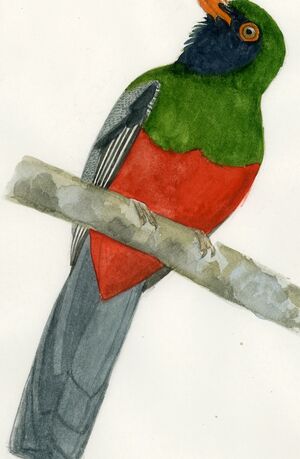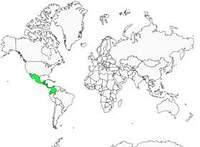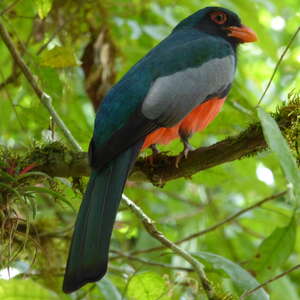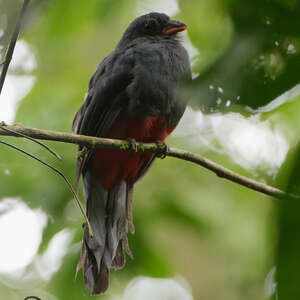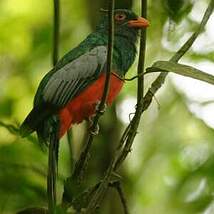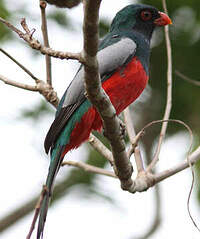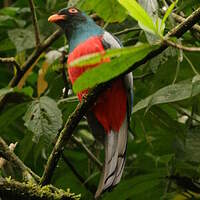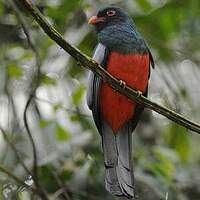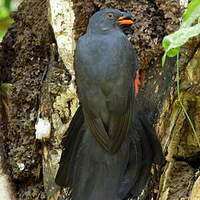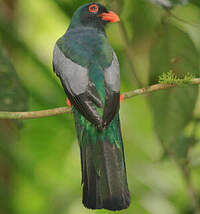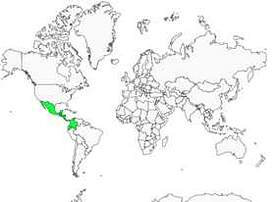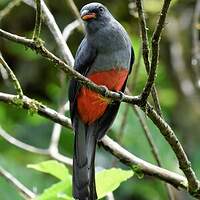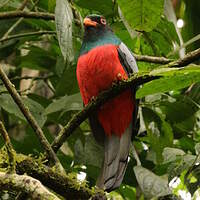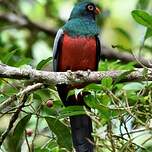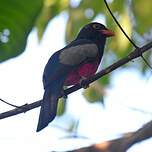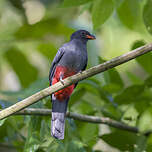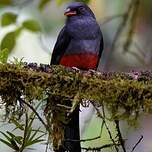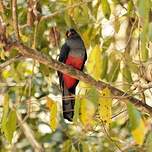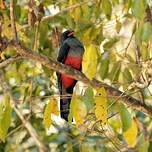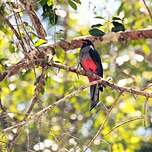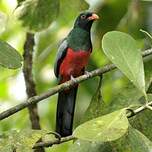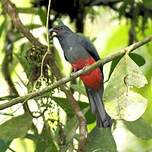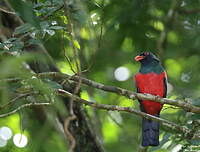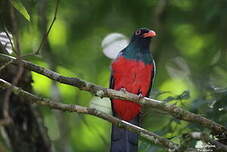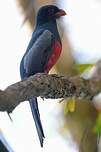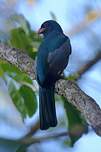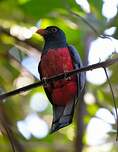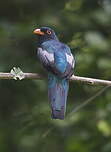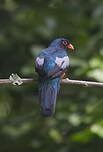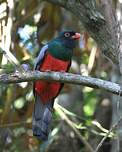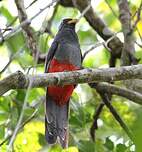Slaty-tailed Trogon
Trogon massena - Trogon de Masséna
Identification
The scientific name of the Slaty-tailed Trogon, or Trogon massena, is derived from the French ornithologist François Victor Masséna (1799-1863), son of the Marshals of the Empire André Masséna. The Anglo-Saxons, perhaps out of old historical rivalry, referred to it more pragmatically as the Slaty-tailed Trogon. This is a large bird at 33 to 35 cm, and like all trogonidae, it has a strong and thick bill with a slightly curved upper mandible. The male has a vivid orange beak and magnificent black whiskers on either side of the beak. The throat, chin and throat patch are dark grey, encircling a large eye surrounded by a very visible orange orbital ring, which is also orange. The forehead, cap, nape, mantle and back are emerald green, giving way to turquoise blue in the rump. The scapulars take on the emerald green colour, contrasting with the light grey coverts. The larger coverts start to darken and alternate between light grey and dark grey, ending at the primary remiges, which are dark grey. On the tail of the Slaty-tailed Trogon prolonging the rump, there are long rectrices that are dark green, which can be greyish in tone, the tips of the rectrices being marked with black, though this colouring is not always visible in the changing light of the canopy. Beneath the dark grey throat, the chest becomes gradually emerald green and a flaming crimson-red spreads halfway down the chest to the underbelly. The legs, often hidden, are light grey. The female may appear to be a different species altogether, with a grey upper mandible, which is an unmistakable distinguishing feature. The orbital ring is still orange, but less thick, and the dark grey of the throat, chin and throat patch is less differentiated from the cap and chest, the bird having lost its emerald green colour of its mate in favour of grey, covering the nape, mantle and back.The chest is also grey and the Slaty-tailed Trogon will also show the scarlet-crimson seen on Mr. The scapulars remain grey and the coverts will rather be anthracite; the remiges will darken to be practically black, the emarginations being white. The rectrices anthracite almost turn to black. The young males are a mixture of the parents' color, they show the father's livery on the back and the mother's on the ventral part, while the young females already have the color of their mother, for both sexes of young their tail is spotted with light white notches visible on the lower rectrices.
Subspecific information 3 subspecies
- Trogon massena massena (se Mexico to Nicaragua)
- Trogon massena hoffmanni (Costa Rica, Panama)
- Trogon massena australis (w Colombia, nw Ecuador)
Foreign names
- Trogon de Masséna,
- Trogón grande,
- surucuá-de-cauda-escura ,
- Schieferschwanztrogon,
- Massena's Trogon,
- Trogone codardesia,
- massénatrogon,
- Oransjenebbtrogon,
- trogón holubí,
- trogon Massenův,
- Orangenæbbet Trogon,
- lyijytrogoni,
- trogon de Massena,
- trogon krasnodzioby,
- Аспиднохвостый трогон,
- オグロキヌバネドリ,
- 灰尾美洲咬鹃,
- orangenäbbad trogon,
- 灰尾美洲咬鵑,
Voice song and call
Habitat
The Slaty-tailed Trogon is exclusively found in Central American forests, frequenting the canopy but often staying at mid-level in dense and humid forests. Near mangroves, along rivers and streams that empty into both the oceans, it positions itself in patches of forest which can remain close to coffee plantations. It is found at moderate altitudes, 500m in Guatemala, up to 1,200m in Costa Rica.
Behaviour character trait
Flight
Dietfeeding habits
Our Slaty-tailed Trogon is primarily a fructivore: the berries of Hamelia (also known as hummingbird bush), Guatteria, Coussarea, and various other tropical fruits, but it will also vary its diet with caterpillars, beetles, or orthopterans that it grabs mid-plunge from the trees. It's known to stay near groups of howler monkey in order to catch the insects that flutter around the primates.
Reproduction nesting
From April to June in Mexico, from February to July in Costa Rica and Panama, the Slaty-tailed Trogon will occupy an old termite nest or excavate a hole in a dead tree, at a height of 3 m or higher in the canopy, up to 15 m. The nest, which will be accessed via an ascending tunnel, is built by the couple. The brood is usually 3 eggs, there is little information about the brooding period and raising the chicks.
Geographic range
Slaty-tailed Trogon, scientific name Massena, is found in eastern Mexico (Veracruz region, Belize, northern Guatemala, northern Honduras and Nicaragua). The South American subspecies, australis, has a male with a blue-turquoise tail instead of the green-emerald colour found in other subspecies. Lastly, the smallest subspecies, hoffmanni, inhabits Costa Rica and Panama.
Threats - protection
IUCN conservation status
concern
in the Wild
threatened
evaluated
The species does not show any signs of decline in its distribution area, at least as long as man does not destroy its habitat. The Slaty-tailed Trogon is a beautiful bird (like all trogons) which is not always easy to observe: climate, thickness of the Central American wet forests, and the difficult to apprehend lighting make it a sought-after subject for all birdwatchers and naturalists. Let's preserve it and respect it for our greatest pleasure!
Sources of information
- IOC World Bird List (v15.1), Gill, F and D Donsker (Eds). 2025-12-07.
- Vol. 6 - Handbook of the Birds of the World, Josep del Hoyo-Andrew Elliott-Jordi Sargatal
- xeno-canto, Sharing bird sounds from around the world,
- BirdLife International, BirdLife International
- Planet of Birds,
- Wikipédia, Wikipedia, The Free Encyclopedia
- Birds of Mexico Central America, Ber Van Perlo
Other sources of interest
 Specification sheet created on
31/07/2023 by Anne et Gabriel Leboff
Specification sheet created on
31/07/2023 by Anne et Gabriel LeboffTranslation by AI Oiseaux.net
© 1996-2025 Oiseaux.net
- Accipitriformes
- Aegotheliformes
- Anseriformes
- Apodiformes
- Apterygiformes
- Bucerotiformes
- Caprimulgiformes
- Cariamiformes
- Casuariiformes
- Charadriiformes
- Ciconiiformes
- Coliiformes
- Columbiformes
- Coraciiformes
- Cuculiformes
- Eurypygiformes
- Falconiformes
- Galliformes
- Gaviiformes
- Gruiformes
- Leptosomiformes
- Mesitornithiformes
- Musophagiformes
- Nyctibiiformes
- Opisthocomiformes
- Otidiformes
- Passeriformes
- Pelecaniformes
- Phaethontiformes
- Phoenicopteriformes
- Piciformes
- Podargiformes
- Podicipediformes
- Procellariiformes
- Psittaciformes
- Pterocliformes
- Rheiformes
- Sphenisciformes
- Steatornithiformes
- Strigiformes
- Struthioniformes
- Suliformes
- Tinamiformes
- Trogoniformes

